
VolcanoCam was shut down in late November, as equipment and communcations loaned to the project were no longer available, and in any case, there wasn't much to see as the eruption had well died down. I would describe VolcanoCam to have been a qualified success.
The volcano is an andesitic cone; eruptions tend to be explosive in nature, ejecting magma in small particles high into the atmosphere. Andesitic volcanoes do this fairly freely however; eruptions are (on a geological scale) fairly frequent and fairly small, particularly compared with the rhyolitic volcanoes in the region such as Taupo (NZ's largest lake, created after the collapse of the magma chamber in the closing stages of a vast eruption tens of thousands of years ago).
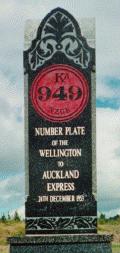 The volcano is
very active. There is a crater lake at the summit of the volcano, kept
warm by volcanic heat. (It's a bit hotter than a nice bath, although some
parts of the lake are at comfortable temperatures. Bathing is however not
recommended.)
The volcano is
very active. There is a crater lake at the summit of the volcano, kept
warm by volcanic heat. (It's a bit hotter than a nice bath, although some
parts of the lake are at comfortable temperatures. Bathing is however not
recommended.)
Ruapehu's last major newsworthy event was the Tangiwai disaster on Christmas Eve, 1953, when heating of the crater lake caused a lahar to race down the Whangehu River, removing the Tangiwai rail bridge right in the path of the Wellington-Auckland express, and 151 lives were lost as the train nosedived into the swolen river.
That changed on the 23rd of September, 1995, as the volcano blasted material high above the crater rim, and sent skiers scuttling down the mountain to safety. Lahars flowed out of the the crater lake and down the mountain as explosions blasted the hot water away from the vent. Huge clouds of steam and ash rose above the mountain.
As the eruption continued over the following days, the idea of getting a camera trained on the mountain was floated.
To describe VolcanoCam as a masterpiece of engineering would simply be false. In fact it was a hack that offended my old commercial software sensibilities. The hardware, consisted of:,
Image capture was done by running a Recorder "script". This script would, in turn, cause the image capture software viewing the frame-grabber's output to save the current scene as a bitmap. It would then go to a running copy of Graphic Workshop, and convert the bitmap into a GIF file. The GIF file was placed where it could be reached via FTP.
Recorder ran at "recorded" speed to give Trumpet and WSFTPd enough time to keep transferring data, even so, there were pauses of some seconds as files were saved.
Back home, a script ran in an infinite loop checking if the GIF file was ready; when it was, it would be FTP'd back to Mako, NetLink's main server, where the timestamp and NetLink logo would be added to the bottom (gotta keep your sponsors happy!), and made available for the world to see.
We now had a system, and on Tuesday 3rd October, were ready to go.
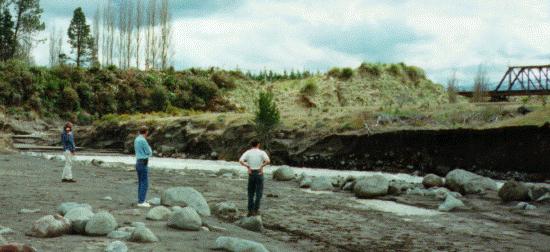
(The picture shows Johnny (with camcorder), Richard and Julian, facing the Whangehu River. To the right is the Tangiwai bridge, which replaced that washed away in the 1953 disaster.)
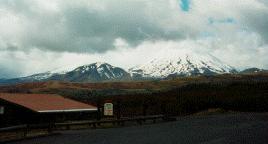 We arrived
at Whakapapa village, at around 2pm ready to set up the camera at the Institute
of Geological and Nuclear Sciences observatory. It was about this time
that we discovered that while the Observatory (which is mainly full of
seismological gear) has a marvelous view of Mt Tongariro, with the almost
perfect cone of Mt Ngauruhoe rising out of its southern flank, its view
of Ruapehu is completely obscured by another building.
We arrived
at Whakapapa village, at around 2pm ready to set up the camera at the Institute
of Geological and Nuclear Sciences observatory. It was about this time
that we discovered that while the Observatory (which is mainly full of
seismological gear) has a marvelous view of Mt Tongariro, with the almost
perfect cone of Mt Ngauruhoe rising out of its southern flank, its view
of Ruapehu is completely obscured by another building.
A little fast talking by Julian and we next found ourselves in the office of Chris Griffin, general manager of the Grand Chateau hotel. We set up the camera and phone, and then discovered we had a problem.
In short, we couldn't keep the link back to Wellington up for any length of time. We got one photo home, but only when someone was holding the antenna of the phone. We resolved to try somewhere else.
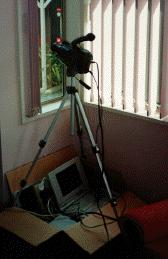 Chris was
good enough to volunteer the services of his living room, so we strolled
down the road and set the camera up again. Cellphone coverage proved yet
again to be a problem, and in the end we had to choose a much poorer camera
position that we would have liked just to satisfy the needs of the cellphone
antenna.
Chris was
good enough to volunteer the services of his living room, so we strolled
down the road and set the camera up again. Cellphone coverage proved yet
again to be a problem, and in the end we had to choose a much poorer camera
position that we would have liked just to satisfy the needs of the cellphone
antenna.
Casual inspection of the antenna suggested it had not been well looked after; I suspect that the actual connection between the co-ax lead and the antenna itself was not good. However, there was no easy way into the connection, and no way to fix it in the field, so we decided to live with it, and the reflections that the location inflicted on the camera. By about 4pm we had our first picture from the final location, and spectacular it was too!
As we retired to the Chateau for a quiet drink and a rest before facing the trip home, we got an inkling as to just how poor the cellphone coverage was at Whakapapa. All of us being cellphone junkies - there was a phone for each body plus one for the camera - we were constantly phoning home to sort out various arrangements associated both with the project and with our day jobs. Very soon we noticed that if one of us was on the phone, the signal strength indicated on our handheld units dropped right back. Worse, if two of us talked, a third often couldn't get a channel at all. While our handheld phones coped with the signal drop-off OK, we found that the camera's unit, with its faulty antenna, was having a hard time.
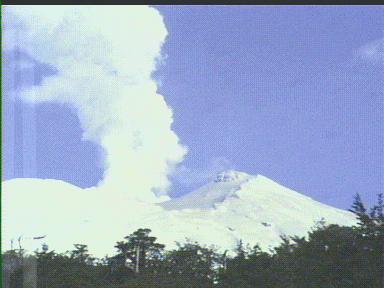 But coping
with flakey communications was part of the design of VolcanoCam; I had
configured Trumpet to redial as many times as necessary if communications
went away, and this it did. With us yabbering on the phone all day, it
only got four frames through before darkness fell, but the following day's
frames s a spectacular sequence of the mountain at sunrise. There were
also a few puffs of ash from the volcano that morning as well.
But coping
with flakey communications was part of the design of VolcanoCam; I had
configured Trumpet to redial as many times as necessary if communications
went away, and this it did. With us yabbering on the phone all day, it
only got four frames through before darkness fell, but the following day's
frames s a spectacular sequence of the mountain at sunrise. There were
also a few puffs of ash from the volcano that morning as well.
But then the clouds came down.
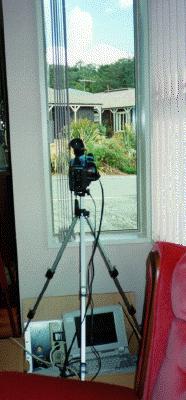 As the weekend
rolled around, we discovered a more serious problem. The power at Whakapapa
was not as stable as we would have liked, and the area was being hit by
occasional power cuts. We had designed VolcanoCam to cope with this; the
laptop had batteries and could ride out a power cut of up to a couple of
hours, after that a cold start would take it straight back into operation.
The modem would just come back to life ready for the laptop to redial it;
the phone was fairly dumb and worked when there was power and didn't when
there wasn't. But the camera was too smart for its own good.
As the weekend
rolled around, we discovered a more serious problem. The power at Whakapapa
was not as stable as we would have liked, and the area was being hit by
occasional power cuts. We had designed VolcanoCam to cope with this; the
laptop had batteries and could ride out a power cut of up to a couple of
hours, after that a cold start would take it straight back into operation.
The modem would just come back to life ready for the laptop to redial it;
the phone was fairly dumb and worked when there was power and didn't when
there wasn't. But the camera was too smart for its own good.
The camera, a modern camcorder, apart from having an auto-focus that occasionally got fooled when the image lacked definition (due to mist or a bright mountain against a bright sky), also did not power itself up when power was applied; it required manual intervention after a power cut to restart it. Chris was happy to do this, but of course Murphy's Law stated that the first power cut hit on the weekend, when Chris was away from the Chateau, and we received nothing but blank frames for a day.
The following week also saw some pressure to return some of the equipment; there had been some misunderstanding regarding the length of the project. Reluctantly, we arranged for the equipment to be returned; meanwhile we scrounged up some gear to replace it.
The University's Department of Theatre and Film came to the rescue with an old video camera; no autofocus, no power problems. If we fed it power, it would feed us pictures. Perfect.
A replacement laptop proved to be a rather complicated arrangement, mostly orchestrated by Jim Baltaxe. Jim Higgins, of The Networking Edge, provided a Zenith Z-note, which alas did not have any PCMCIA slots, so it was used to replace a Compaq Aero in use in VUW's Faculty of Commerce. That unit, unfortunately, would not work with the PCMCIA frame-grabber, so one of NetLink's staff used the Aero for the remainder of the time VolcanoCam was operating, with his Compaq Contura laptop gracing the mountain.
Since there was some pressure to get the thing back on the air, we did not attempt to change the software or otherwise complicate the issue. In hindsight, we should have done something about the cellphone, which eventually deteriorated to the point where it was only rarely making connections, fortunately well after the interest had died down.
Within a day of getting the equipment back in Wellington, VolcanoCam Mk II was ready to go. That weekend, Jim Baltaxe drove up to Whakapapa to install the new equipment.
Once again, the final nemesis of VolcanoCam was the communications, and on two fronts. By the time Telecom Mobile decided they wanted their phone back in late November, the antenna problems had reduced VolcanoCam's success rate in getting images home down to a few images a day, if that.
The last live picture from VolcanoCam was transmitted on the 26th of November, at 8:35. It showed the tree-line and impenetrable murk, something of a recurring theme in VolcanoCam pictures.
But in the mean time, the camera provided some spectacular pictures.
The sequence below shows one explosion. One can see the plume rise between
each frame. What is perhaps hard to grasp is that the frames are each a
minute apart; the space shown above the mountain is over a kilometre high,
and that cloud of ash is climbing at rates of hundreds if not thousands
of kilometers per hour.
Why did we do it? I can't speak for the others involved in this project. For me, volcanoes, earthquakes, pretty much any example of Nature throwing her weight around is something I find interesting. I've explored the Hawaii volcanoes, and thermal areas in the central North Island, and having a real live eruption to play with was just too good an opportunity to miss.
There was an element of "this is cool" about the exercise as well. There's a lot in that.
Once again, the thing that made VolcanoCam possible, and the thing that brought it down was the communications. Remote stations are expensive to run when the communications have to be paid for at market rates, and without sponsorship, nobody was going to fork out the hundreds of dollars a day required to keep the comms running.
Similarly, the communications link has to work.
If I was doing it again (and had a bit more notice, and a lot more time), I'd be very much inclined to put together a better piece of software, and go over the comms with a fine tooth comb before putting it into service. A number of suggestions for Internet cameras have been floated, such as for traffic monitoring at intersections, and these really require a thoroughly robust system.
That said, VolcanoCam's environment was hostile - the site was largely unattended, the power was flakey and the communications very poor. If we'd had more time and more money, I'd have been much happier with a terrestrial connection rather than any kind of radio link.
Some thought has been given to building a portable unit, with proper software, that can be placed at any interesting spot.
Another thing that would have made VolcanoCam (or any Internet camera) more interesting would have been to make the camera steerable, or at least had control of the zoom so that more or less of the plume could be monitored.
Better comms would always help; the modem was restricted to 4800bps because of the poor performance of the cellphone, which restricted image capture to about one a minute. Faster transmission (coupled with faster image capture) would have made the system more interesting.
Postscript: 18 June 1996
As I write this, Ruapehu is erupting again. Inevitably, there are calls to put VolcanoCam back online.
Would I do it again? Probably not, at least not in its previous form. What I'd like to see is a fixed camera at one of the IGNS stations, where there is already a decent Internet link in place, rather than trying to place a semi-portable device on any kind of radio link. While this means that it will be too far away to catch some of the spectacular pictures VolcanoCam captured, the full view of the plume is of more scientific interest than a view of just the vent itself.
In any case, we've done that one. New projects await...
Don Stokes don@daedalus.co.nz, June 1996